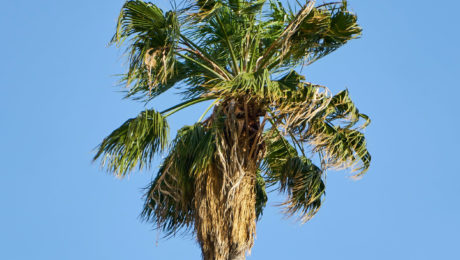Washingtonia Robusta vs. Washingtonia Filifera – Differences
Washingtonia robusta and Washingtonia filifera are both species of palm trees commonly known as Mexican fan palm and California fan palm, respectively. While they share similarities, they also have distinct differences.
- Geographic Origin:
– Washingtonia robusta: Native to northern Mexico.
– Washingtonia filifera: Native to southwestern North America, particularly in California’s desert oases and areas of Arizona.
- Trunk Appearance:
– Washingtonia robusta: Typically has a smooth trunk, often with remnants of old leaf bases that have fallen off, leaving distinctive diamond-shaped scars.
– Washingtonia filifera: Usually has a thicker trunk with a rougher texture due to the persistent leaf bases that form a crisscrossing pattern.
- Leaf Characteristics:
– Washingtonia robusta: Its leaves are darker green, with a smoother texture, and typically more robust.
– Washingtonia filifera: Its leaves are lighter green, often with a slight bluish hue, and have threads of fibers along the margins, giving them a frayed appearance.
- Growth Rate:
– Washingtonia robusta: Generally grows faster than Washingtonia filifera, making it a popular choice for landscaping in warmer regions.
– Washingtonia filifera: Tends to grow more slowly but is more cold-tolerant, making it suitable for cooler climates within its range.
- Overall Appearance:
– Washingtonia robusta: Often regarded as having a more slender and elegant appearance due to its smoother trunk and darker leaves.
– Washingtonia filifera: Typically appears more robust and stately due to its thicker trunk and frayed leaf margins.
- Landscape Use:
– Washingtonia robusta: Commonly used in urban landscaping, particularly in warmer climates, due to its rapid growth and tolerance to pollution.
– Washingtonia filifera: Often preferred for more naturalistic landscapes, especially in desert and Mediterranean-style gardens, due to its slower growth and more cold-hardy nature.
- Flowering:
– Both species produce large, branching inflorescences of small, cream-colored flowers.
– However, Washingtonia filifera typically blooms earlier in the year compared to Washingtonia robusta.
- Seed Production:
– Both species produce round, black fruits that contain small seeds.
– Washingtonia filifera tends to produce larger and more abundant fruits than Washingtonia robusta.
- Cold Hardiness:
– While both species are relatively tolerant of heat, Washingtonia filifera is generally hardier to cold temperatures and can withstand occasional frosts better than Washingtonia robusta.
– Washingtonia filifera is often preferred for planting in cooler, inland areas or higher elevations within its native range.
- Water Requirements:
– Washingtonia filifera is more drought-tolerant than Washingtonia robusta, making it a suitable choice for xeriscaping and water-conserving landscapes.
– Washingtonia robusta typically requires more consistent watering, especially during hot and dry periods.
- Landscape Considerations:
– Washingtonia robusta is often favored for its fast growth and adaptability to urban environments, making it a popular choice for street planting and landscaping projects in warmer regions.
– Washingtonia filifera’s slower growth and greater cold tolerance make it more suitable for naturalistic landscapes, parks, and residential gardens, particularly in areas with colder winters.
- Pollination:
– Both Washingtonia robusta and Washingtonia filifera are pollinated by insects, primarily beetles and bees attracted to the flowers’ nectar.
– The flowers of both species are generally dioecious, meaning that individual trees are either male or female. Female trees produce fruit after successful pollination, while male trees produce pollen.
- Seed Dispersal:
– The fruits of both species contain small seeds that are dispersed primarily by birds and mammals attracted to the fruit’s pulp.
– Seeds are also dispersed by wind and water, allowing for colonization of new areas, particularly in riparian zones and other habitats with suitable growing conditions.
- Germination and Seedling Growth:
– Washingtonia robusta and Washingtonia filifera seeds germinate readily under favorable conditions, typically in warm, moist soil.
– Seedlings of both species are relatively fast-growing, with the ability to establish quickly in suitable habitats, particularly in disturbed areas or where competition from other vegetation is limited.
- Propagation:
– Both Washingtonia robusta and Washingtonia filifera can be propagated from seeds, which are collected from mature fruits and sown in well-draining soil.
– Propagation from offsets or suckers is also possible, as both species produce clusters of offshoots at the base of mature trees. These offshoots can be carefully removed and replanted to establish new trees.
- Genetic Variation:
– Both species exhibit genetic variation within their populations, resulting in differences in traits such as growth rate, leaf morphology, and cold tolerance.
– This genetic diversity allows for adaptation to local environmental conditions and may influence the suitability of specific individuals or populations for landscaping or conservation purposes.
- Summary:
In summary, while Washingtonia robusta and Washingtonia filifera share many similarities as tall, iconic palm species, their distinct characteristics in terms of trunk appearance, leaf texture, growth rate, cold hardiness, and landscape suitability allow landscapers and gardeners to choose the species that best fits their specific needs and environmental conditions.
Overall, the reproductive biology of Washingtonia robusta and Washingtonia filifera is similar, with both species relying on pollinators for reproduction, dispersal mechanisms for seed spread, and various methods of propagation for regeneration and cultivation. Understanding these aspects of their reproductive biology is essential for managing and conserving these iconic palm species in natural and cultivated settings.
While these differences help distinguish between the two species, it’s essential to note that they are both tall, majestic palms widely cultivated for their ornamental value and ability to thrive in various climates.
- Published in Garden
